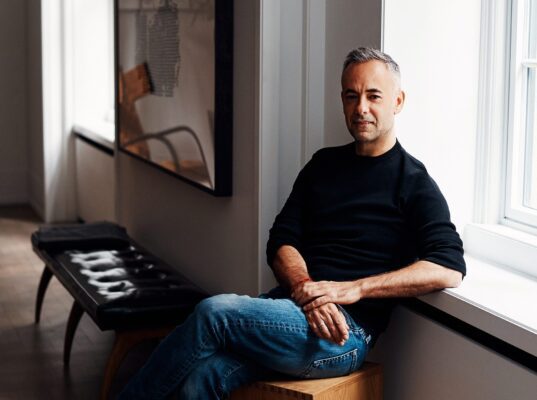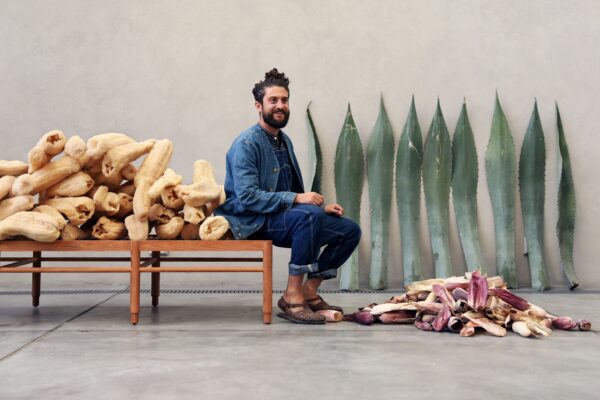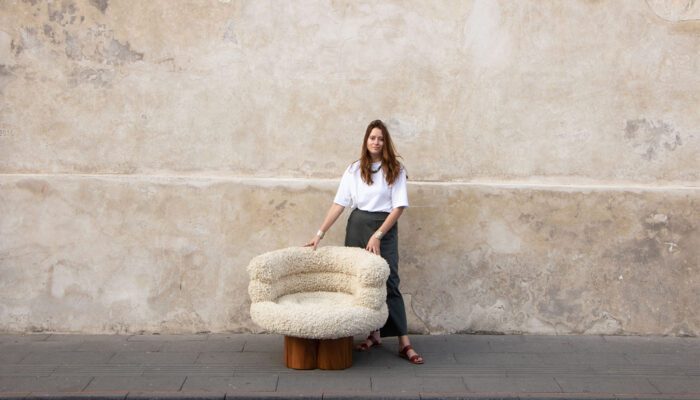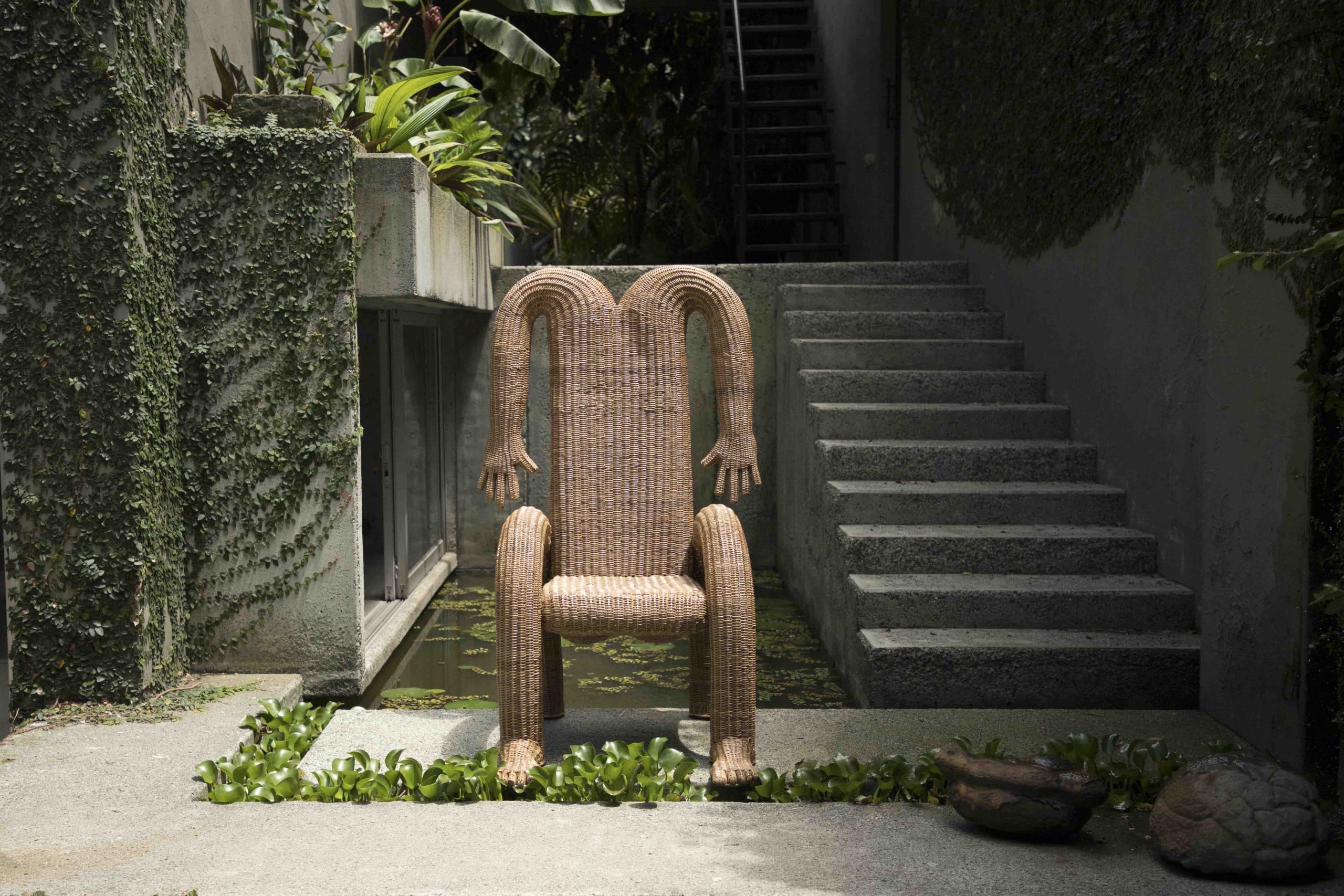
COFFEE WITH
CHRIS WOLSTON: “IN MEDELLIN, I WAS ALWAYS DEVELOPING MORE INSPIRED WORK”
Name: Chris Wolston
Profession: Artist
Birthplace: Providence, Rhode Island
Zodiac Sign: Aries
Instagram: @chriswolston
LATINNESS: Chris, tell us about yourself. How did you end up in Medellin?
CHRIS: Well, I went to Rhode Island School of Design, and a friend of mine, actually, one of my classmates, is from Medellin. When we graduated, he returned back to his family’s old farm just outside the city, going up towards Santa Elena, and he started an artist residency, and so, when he opened the program, he said, ‘Hey, why don’t you come down and try out the first session?’ I, simultaneously, was applying for a Fulbright grant. I was interested in looking at manual manufacture modes of production, how material was used in small scale production environments and artisanal applications of material, and so I went to Medellin for three months, and I totally fell in love. So I applied for a Fulbright grant to return, and the following year, I went back for the year and was researching pre-Columbian ceramics and sort of the place of terracotta in the material culture. So that’s how I got my foot in there. Then I ended up setting up a studio and sort of being back and forth between Brooklyn and Medellin, and at this point, I spend most of my time in Medellin.
LATINNESS: Before your move to Medellin, did you have any experience with Latin culture, or with Colombia, in particular?
CHRIS: Well, I think a lot of the introduction before I had gone down to Campos de Gutierrez with the artist residency in Medellin, where I went in 2012, what I knew about Colombia was from a close friend of mine in university who’d grown up in Medellin and left in the late 90s.
I came down with a specific experience of someone in particular in mind, and also, sort of, growing up in the United States, there was a specific idea about Colombia, which is, you know, inaccurate in ways, especially at that time. And so for me, it was this interesting experience where I had come down, primarily to do some field work for potentially putting together a Fulbright proposal. I had studied French in school, and so my language skills were very basic. It was this interesting experience where I found myself, while I couldn’t communicate verbally, I felt that there was a deeper sort of language in visual culture and the culture of making.
And so, for me, the Fulbright, in many ways, was this interesting experience of learning culture through a viewing process, doing, making and jumping into these settings, like manual brick factories or aluminum foundries, and working hands-on so, diving in headfirst with just the intention of making, and just working with my hands with the guys there.Through that, I’ve learned Spanish, and I still am not at a place where I can speak about my work in Spanish because I’m doing a little bit more nuanced than I can, but it’s been an incredible experience about learning about Colombia and learning about Latin culture, and through sort of throwing myself in and immersing myself. My partner lives in Medellin. He’s actually there now. So we are apart for the indefinite future, which fortunately is OK because, you know, we’re back and forth traveling.
LATINNESS: We read that an aluminum hot chocolate pitcher in your apartment started your research. Can you tell us a bit about that?
CHRIS: Well, so I guess, like when I first got to Medellin, I was working with a pre-Columbian ceramic archive at the University of Antioquia, and I was interested in looking at how this singular material fit into the material landscape of a city. So, at first, when I was working with terracotta, I was interested in the fact that it existed, both in the historic culture, pre-Columbian tradition, and it was present in architecture through all of the extruded bricks. Obviously, there are apartment towers built of brick. The barrios rising up the mountainsides from the city are this orange color, and so when you’re in the valley of Medellin, there’s a feeling of being surrounded by this material. So I had taught a series of workshops with kids from around the city, and one of the things that I did is I had everyone bring in a handful of earth from around their house. This was sort of an experiment. I didn’t know if it was going to work, but we processed all of that dirt into clay, which the kids made pieces with, and we went in, we installed them around town. So it was this material that was in all walks of life, and one of the other materials that I discovered, which I found was everywhere, was the sand cast aluminum. You know, in any tienda there would be a lemon squeezer, or an empanada maker or a chocolatera. I found this chocolatera at a tienda in Centro, and the interior of it was sand cast aluminum. So it was that sort of crude aluminum, rough surface and the outside was spun, so it was this very sort of polished tool. You could see the lines of the spinning process, and then the handle was a separate sand cast piece that was riveted on. I thought to myself, ‘This is absolutely incredible’. Like here is this handmade thing. It’s cast metal. It’s undergone all these different processes, but it’s ubiquitous. You know, it was not this, like, artisanal thing. It was just an everyday object, and I was fascinated by that, sort of in terms of process, and also how value gets placed on material. So I made friends with the different vendors and people selling this type of thing, and I got the name of the guy that made the chocolatera, and tracked it back to Niquitao, which is a neighborhood in Centro. I ended up setting my studio up there some years later, across the street from the foundry. I think we worked in Niquitao from 2016 to 2019, and then at the end this past December, we moved to a different space in Prado Centro. So that’s how I came to the chocolatera, and that I came to sand cast aluminum.
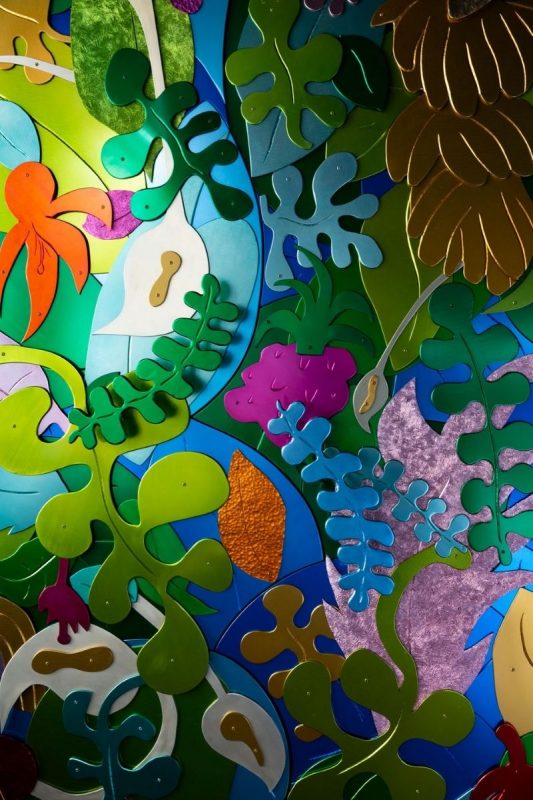
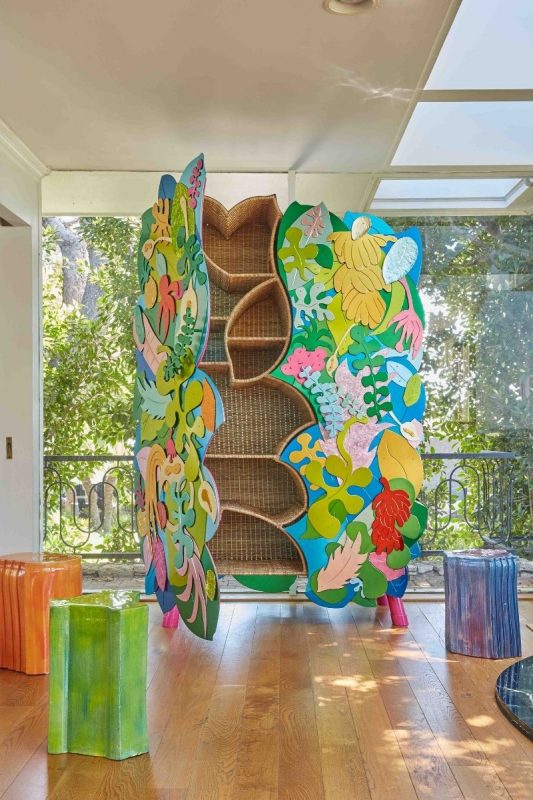
LATINNESS: Is that how you started creating your coffee table?
CHRIS: What I was interested in was to see the environment where this thing was made and how it was done. You know, my first visits, I was just there like watching and trying to learn the process. Then after I had sort of an understanding of how sand cast aluminum worked, I started coming up with ideas for different pieces. Then fast forward a little bit, the coffee tables and the dining tables that are made of the puzzle pieces, sort of grew out of the fact that the aluminum foundry was actually quite small, and the furnace was not of a large capacity, so I came up with this idea to make tables out of smaller pieces because we could cast individual pieces and then put them together. Obviously, there are foundries in Medellin that can do larger scale castings, but part of this, for me, was about the relationship that I developed with Alfonso, who runs the foundry, and trying to come up with ideas within a given setting. I think one of the things, for me, that was so inspiring, when I first came to Medellin, was that there was sort of an ingenuity and resourcefulness when it came to material, and I used to sort of describe it as, you know, material culture seemed to be much more fluid than the material culture that I had grown up in and was used to. That openness and open-mindedness to working with materials with unrestricted experimentation, I think it inspired in me a sense of discovery. That was really the foundation for creating many of those first works.
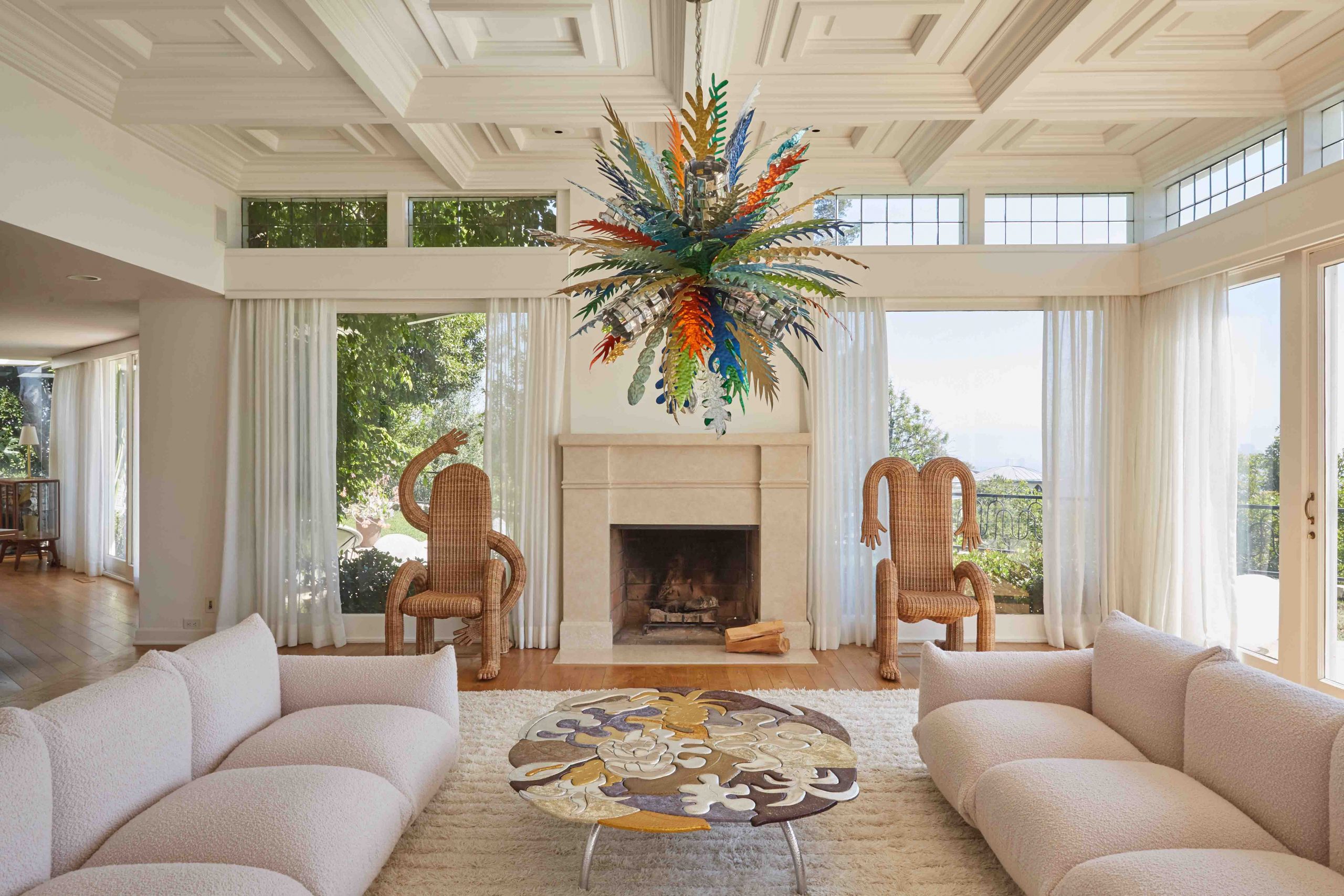

LATINNESS: You have a studio in Medellin and one in New York. What would you say are the main differences between each?
CHRIS: All of the different talleres and shops and studios that we’ve worked with outside of the studio, there’s just an incredible warmth and openness to experimenting, and I found that, in the United States, if I were to go talk to an anodizer and say, ‘Hey, I want to anodize sand cast aluminum’, they’d look at me like I was crazy. They would say, like I mean, I’ve actually asked around in the States before experimenting in Medellin, and everyone said, ‘No, it’s impossible’, like the metal would turn black. In some ways, I found that sort of outlook or perspective or attitude to be disenchanting. It was the sort of thing where I just was pursuing what I felt most inspired by, and over the years, in my time in Medellin, I always was developing more inspired work. Now that it’s sort of been over these years, at this point, I can look back in and sort of make that distinction. It wasn’t like I just came and was like, okay, I’m going to make everything here. It was really, the time that I spent there is when I felt most inspired, and was able to generate work that was both exciting and new, I think.
The things I make are sort of one of a kind. We’ll do small editions, and so we’re not working in large numbers. I think, oftentimes, in the US, if you approach a place and you’re not making ten thousand of something, they’re just going to laugh at you. Then the other thing I mentioned was that we moved the studio to Niquitao, which was next to the foundry, but within a six block radius of that studio, you know, the foundry was across the street, the aluminum polisher was around the corner, and all of this sort of material that, you know, the laser cutter, the aluminum store or the sheeting, everything was in a six block radius. For me, that was so exciting because there was this sense of community where we were working with our neighbors, and it’s interesting that, now that we’ve moved the studio, we’re still back in the neighborhood all the time working with them. For me, that was part of the excitement and the inspiration, creating those relationships.
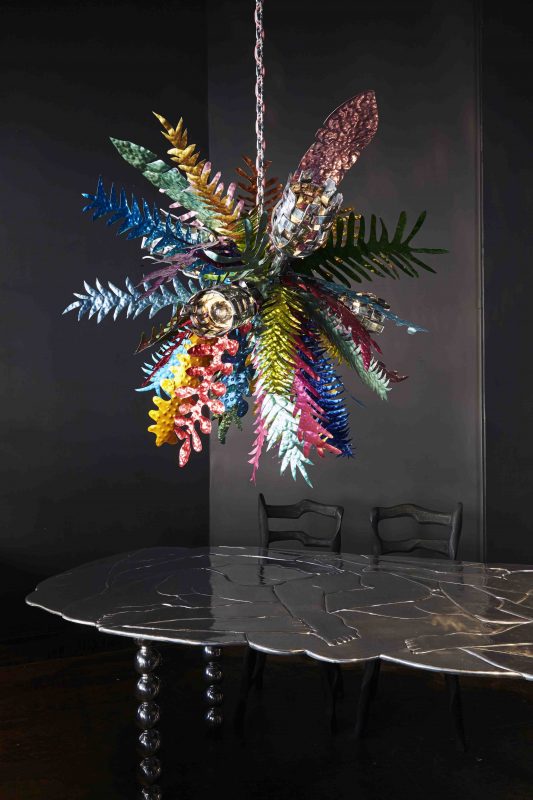
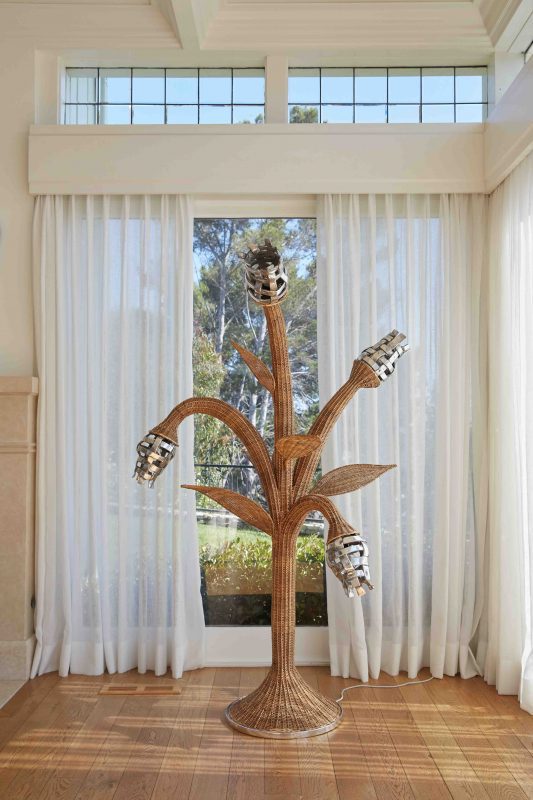
LATINNESS: Talking about all these years of work as a designer, when would you say was your big break?
CHRIS: Most recently we have been working on the Nalgona chairs, which I presented this past year at Design Miami, and they are a collection of these different humanoid forms, chairs that are also human. You’ll hear me saying ‘we’, and it’s because the team involves so many different people, and I think that is a really important part of it. The weavers that we work with are a collective that’s up on the mountainside outside the city, and so we make all the frames in the studio, we powder coat them in Centro, and then we drive them up the mountain to be woven. There has been a real excitement with these pieces. I enjoy that because part of what I wanted to do in setting up this studio in Medellin was to create works there that would travel to other places and sort of tell a story. At the time of my Fulbright, when I was going down to Colombia, not many people had a really good idea about the place, and I felt that I was so inspired by this environment, and there was so much more to it than what everybody seemed to know about back in the States. At that point in time, I thought, like, ‘Wouldn’t it be nice to create these things here that could tell a different story?’ And so the chairs, I think, really bring a lot of joy to people, and through sort of a presentation of materiality, right? I think everybody’s familiar with wicker, but what has been so successful about the Nalgona chairs is that it’s really presented in a different way.
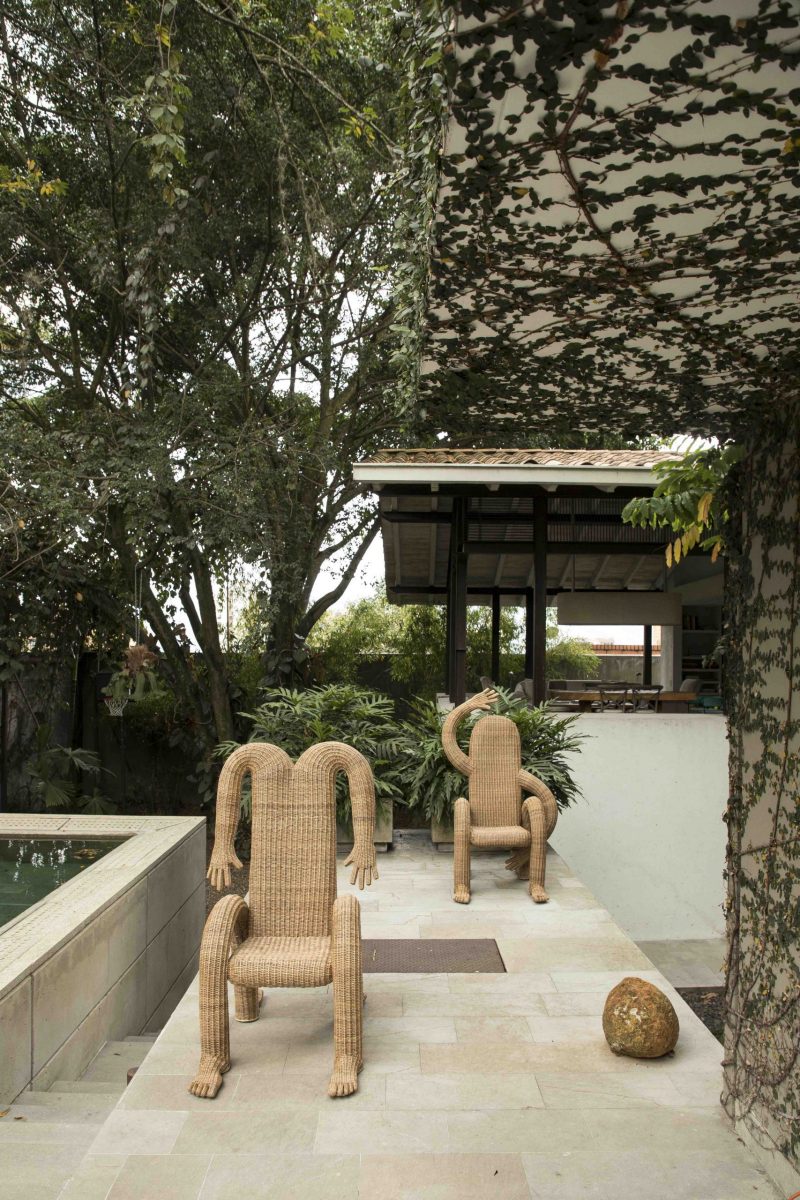
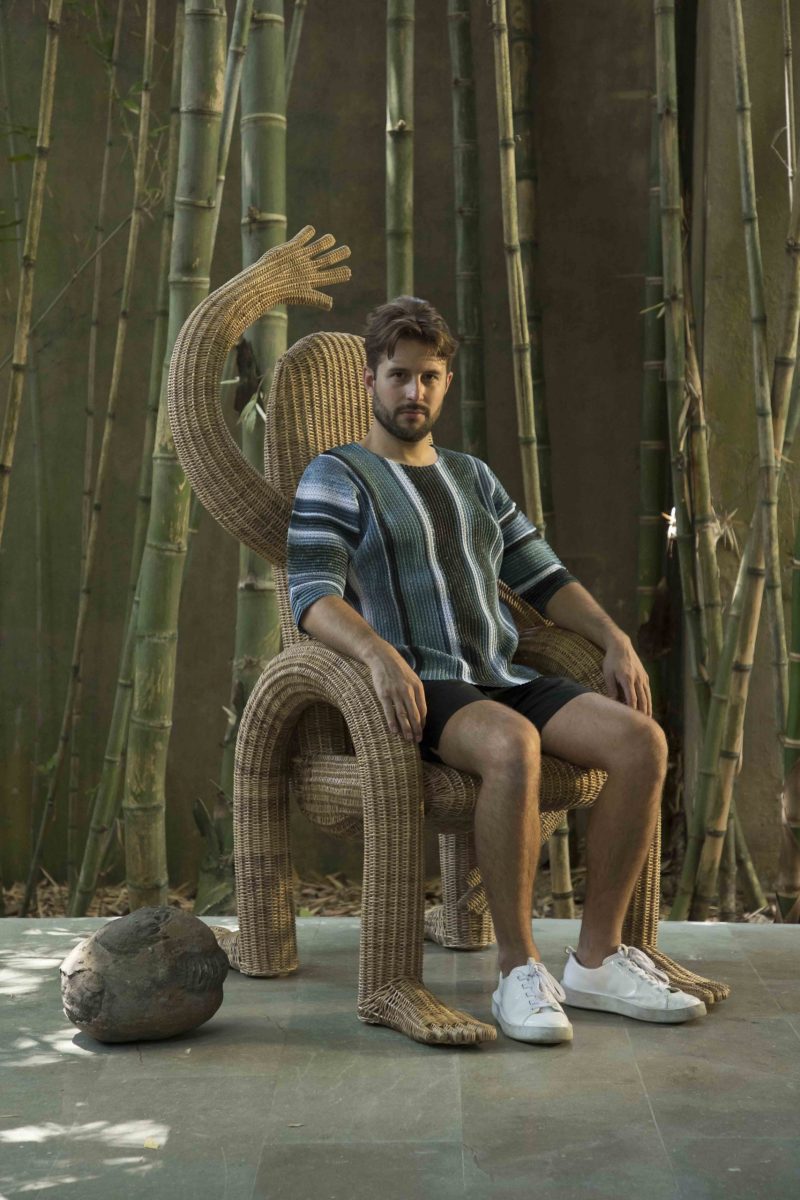
LATINNESS: Was this the first time you worked with wicker?
CHRIS: Well, actually, in 2018, wicker entered my work. I did a show in New York with these different wardrobes where the exterior was anodized aluminum and the interior was woven wicker. So after doing the collection of sand cast aluminum -which was very hard and heavy- I wanted to sort of call in a material that was soft and lightweight and very comfortable to the body. So we did the launch of those chairs. There were two that were released in July in a little summer show we did in Los Angeles, and then we did a collection of four in Design Miami in December. It hasn’t even been a year yet.
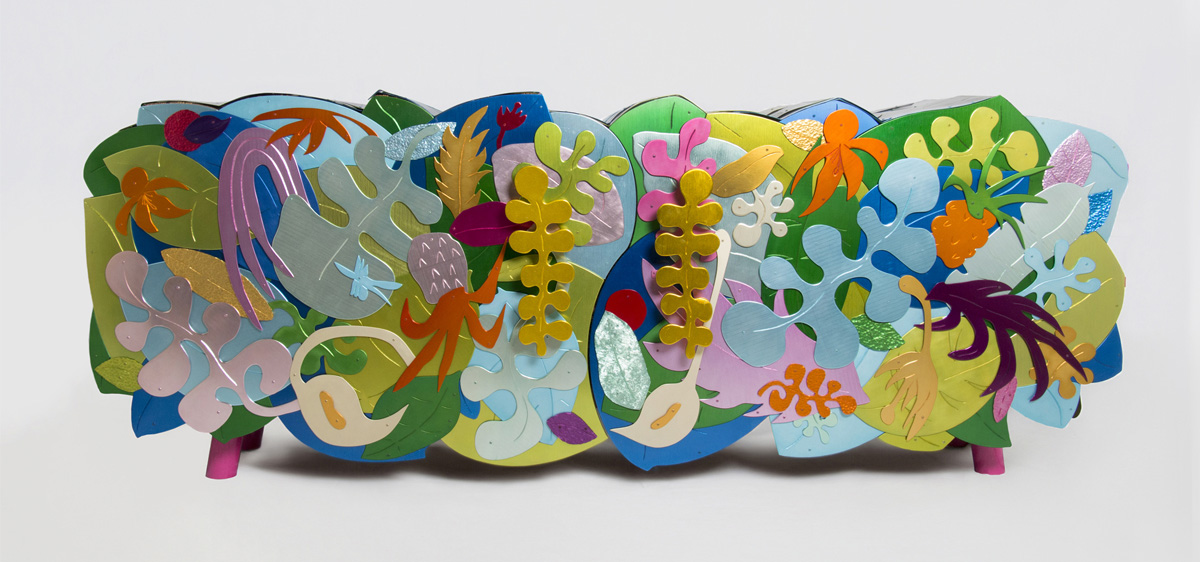
LATINNESS: Wow, not even a year and it’s been a huge hit- congrats!
CHRIS: Yes, it’s been fun, and actually, you know, interestingly, the show that I was flying to the Middle East to put on, you know, one of the things that’s important to me is telling the story and also highlighting everyone that we work with. So we, actually, were flying three of the weavers to Qatar to do a demonstration of the weaving as part of that show, and so that’s been postponed until next March.
LATINNESS: That’s truly beautiful. Hopefully you guys can do that in the near future and bring some Colombian flair to Qatar. Now to fashion: We heard you did a collaboration with Fendi for the Peekaboo 10th anniversary.
CHRIS: We did. Yeah! That was Design Miami in December 2018. So after my show in New York, Fendi got in touch about doing a Peekaboo bag like an artist one off. So I did a bag that was in line with the anodized wardrobe that I had done for the last show, where I had a series of different flower and leaf drying, so we were inspired by my garden in Medellin. Those pieces were cut out of aluminum and engraved and riveted onto the exterior of the Peekaboo bag in this three dimensional metal collage, and that was an exciting experience we did. My partner is a fashion photographer in Medellin, so he put out a call for models to see who would be interested in doing a shoot. We got three really great models from Medellin, and David did a fashion film and a series of pictures to go along with that, which was an exciting sort of component to also present with the bag. It was for their 10th year anniversary of the Peekaboo bag, so they put on a show at Design Miami for the anniversary. There were five artist bags made for the show. There was an artist from Hong Kong, Sabine Marcelis, who had also done the Curio booth at Design Miami that year, and some other really great artists.
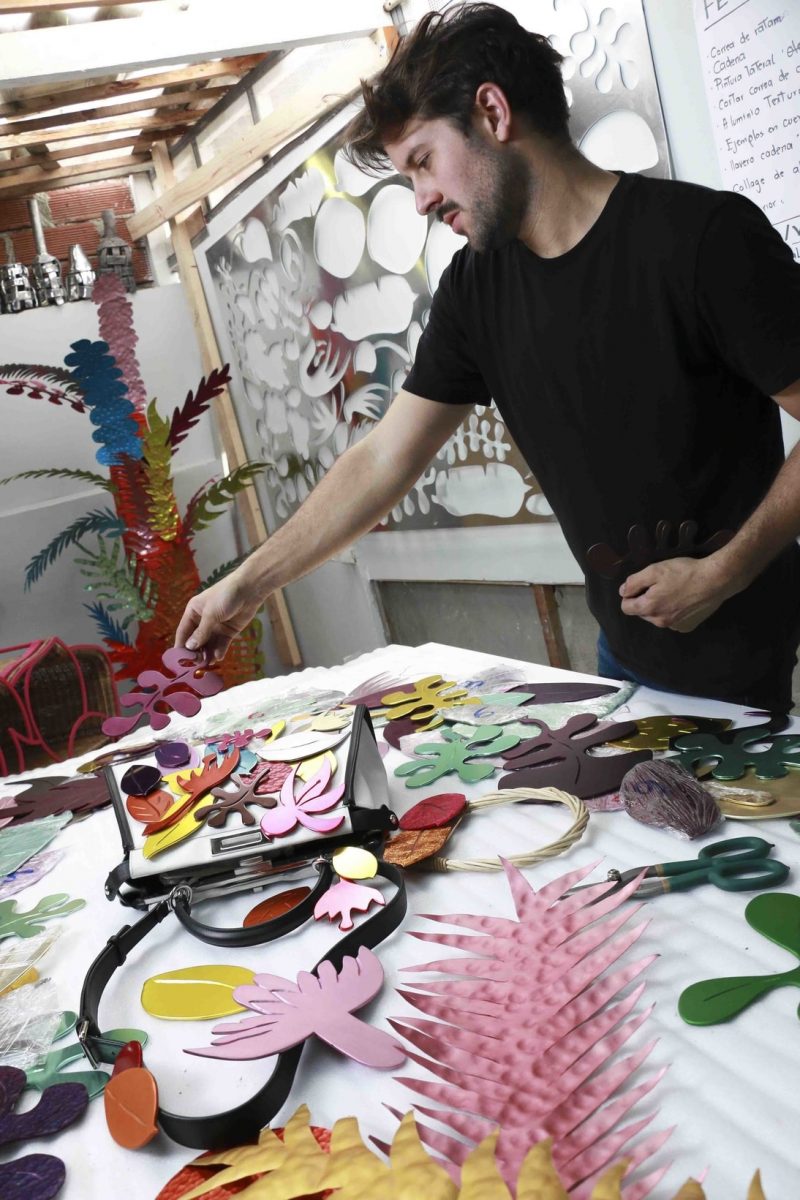
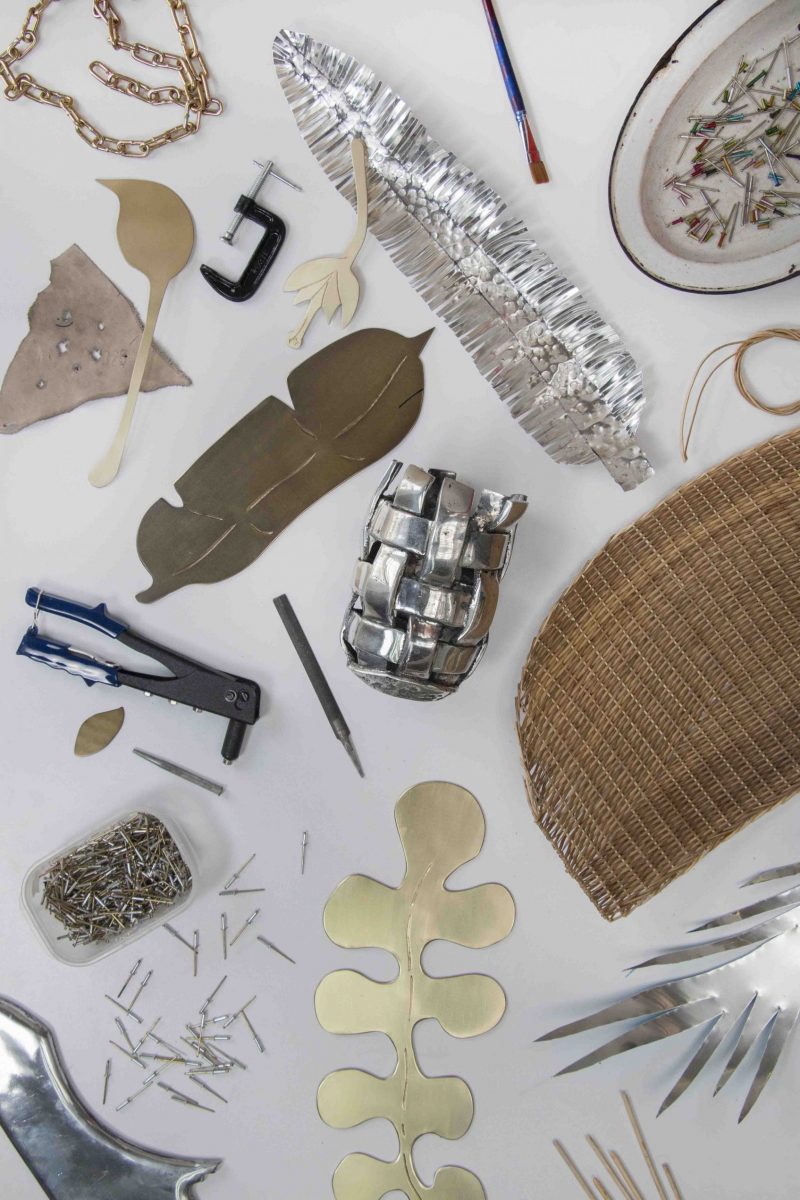
LATINNESS: Did you find that the creative process was different working with fashion?
CHRIS: Well, it’s an interesting question, actually. One of the reasons I started making furniture was because I sort of thought of my pieces as relational sculpture when I first started making furniture, and I still think of them in that way, but it was a way to present material for people to interact with. I think that fashion is similar because it is related to the human form, there is this element of interaction, and, for me, that was an interesting part of this. Sort of taking a material that was part of these massive wardrobes that I was making, and adding it into a format that could be carried as a handbag.
LATINNESS: More functional in a way.
CHRIS: Yeah, and I just found that, like with furniture or with fashion, people are able to connect with material in a more sort of easy way. I think that, at least with furniture, the same could be true for clothing, you know, people have a very intimate relationship with furniture. You know, I’m sitting in this chair now, and I don’t even think about it. I’m just sort of lounging here comfortably, and I think that changes the dialogue between, you know, for example, the Nalgona chairs, which are wicker and applied in a very different way. There are thought processes that happen about that material when you’re actually interacting with it, when you’re sitting up. Or in the case of a Fendi bag, when you’re, you know, carrying this bag that’s made out of sheets of metal that are riveted together.

LATINNESS: I first heard about your work through Casa Perfect. I was at the location in Los Angeles and liked a table, and when they told me it was made in Medellin, I was thrilled to know they were representing design from Latin America. Can you tell us about your experience with them
CHRIS: I love hearing that! It must have been one of the sand cast aluminum tables. So Casa Perfect is my gallery in New York where everything that I make in Medellin is with the Casa. There is the location in New York and Los Angeles. What’s amazing is that from, you know, the first time that I was in Medellin in 2012 till now, Medellin has sort of changed, like drastically, and in this incredible way. I find that so many people are down visiting and have been, and it’s exciting to learn that, you know, through hearing about something that connects from there and sort of following it back, sort of in the reverse way, creates like a dialogue.
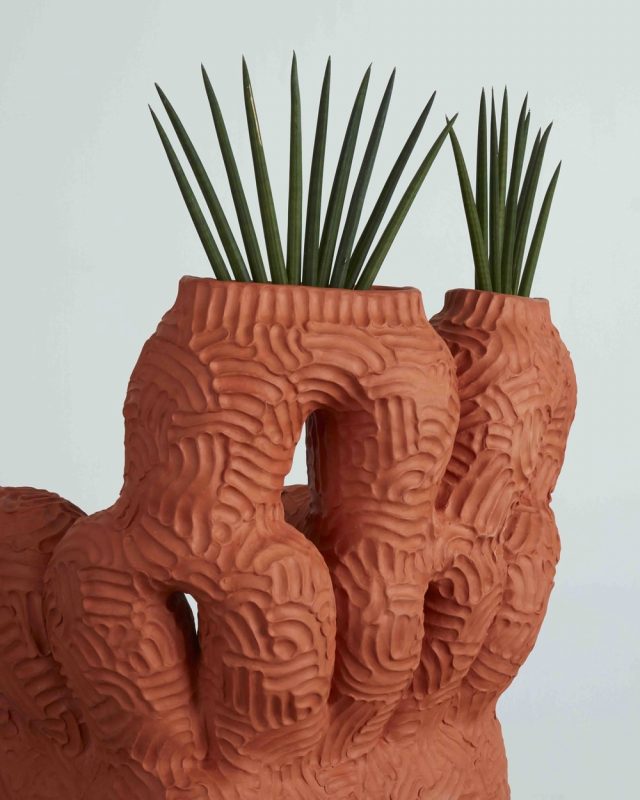

LATINNESS: What would you say is your favorite part of Latin culture?
CHRIS: Jeez, like the paisas. I have so much admiration for everyone, like how warm and friendly everyone has been, in my journey to setting up a studio and creating a life in Medellin. There is a warmth that I had never experienced before. I think there’s something really special about that. And, you know, another thing is that the natural landscape totally blows my mind. My house is actually up in the mountains. It’s like one of the first rural districts outside the city. Medellin is a valley, so it’s surrounded by the ranges. You can, you know, in one part of the day, be down in the valley and sort of, you know, hot temperatures, and then, another part of the day, be up in a temperate rainforest. And it’s the journey from those two different environments can be, you know, if you take via Santa Elena, it’s this incredible switchback road which has this sort of effect of like descending or ascending in an airplane. It’s just magical! I think that with the last collection that I did, the Lost In Paradise collection, was really inspired in many ways by the landscape in my garden and wanting to bring that tropical experience into people’s homes around the world. When I conceived the tropical wardrobe, I was in New York, and it was summer, and I was just like, ‘What do I want? I really miss my garden.’ So I thought, ‘Why don’t I create a wardrobe that embodies this?’
LATINNESS: What’s your favorite neighborhood in Medellin and why?
CHRIS: Well, we just moved the studio to Prado Centro. Prado is full of these big old homes, many different architectural styles, and I find it really inspiring walking around and seeing all of the different types of architecture from different periods. I think a lot of the older style buildings, like traditional style structures have been torn down and new buildings have been erected, and I think that in Prado, there’s still this element of architectural past or architectural residue. I think that’s interesting. I love when I take the bus down, actually, from where I live on via Santa Elena every day, and so I get off at La Placita de Flores, and I think that is another, like, major source of inspiration for me in terms of the sort of different traditional vendors that are there and the sort of tiendas with colloquial materials, and, you know, there’s a lot of the sand cast aluminum and that typology.
I also think that there’s a certain madness to Centro, and I think that there is something really inspiring about walking around and there’s so much to see! In 2012 I did a series of sculptures that were made out of salvaged terracotta bricks stacked on top of each other with with cement in between, kind of like these cakes, and they were painted with different sort of glitzy paint colors and different things, and it ended up being called Everything Comes In Through The Eyes, and it was sort of a response to being in Centro and having all this stimuli and aesthetic input, and then stepping back.
LATINNESS: Favorite restaurant?
CHRIS: Alambique is great. There’s a spot in Centro called Donde Nico, which has my favorite chorizo in Medellin. When people come to visit, I always take them to Alambique. It’s a fusion of really traditional paisa foods and sort of new cooking traditions like ceviche or Torre de Choclo casserole.
LATINNESS: Bakery or coffee shop?
CHRIS: Tres Trigos.
LATINNESS: Outdoor market?
CHRIS: La Placita de Flores or La Mayorista.
LATINNESS: Favorite ice cream shop?
CHRIS: Amar Acuya.
LATINNESS: Favorite park?
CHRIS: There’s a place in Envigado. It’s called El Salado, and there is sort of like a ropes course park or something, like up at the top of this road. If you keep going up the road, it ends at a river, and you can keep hiking. I think it’s maybe a national park or something like that. There’s rivers and there’s a little place, you have to cross this bridge over a river, and there’s a place that does trout. So it has a little fish pond, and you catch the trout and they cook it on the fire. Also in that area, in La Miel, there’s a hike called Tres Campanas, and it goes up to this beautiful waterfall.
Image credit: Courtesy of Chris Wolston

